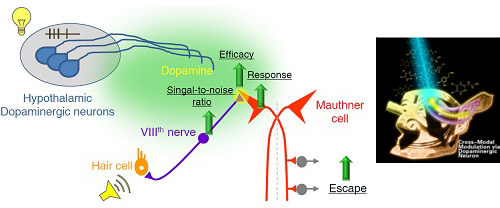Time:2012-08-23
On August 23, 2012, Neuron published a research article entitled "Visual Input Modulates Audiomotor Function Via Hypothalamic Dopaminergic Neurons Through A Cooperative Mechanism". This work was carried out by graduate students Yu Mu and Xiao-quan Li in the laboratory of "Sensory Integration & Behavior", under the supervision of Dr. Jiu-lin Du at the Institute of Neuroscience, Chinese Academy of Sciences.
An essential feature of sensory perception is to combine sensory information from distinct sensory channels to direct proper behavior and ensure high survival. Such combination can be achieved through integrating sensory information from multiple channels (Multisensory Integration) or modulating signal processing in one channel by inputs from other channels (Cross-modal modulation). In the past several decades, the phenomenon of cross-modal modulation has been widely described and well characterized in many species at neurophysiological, perceptual and behavioral levels. However, due to the complexity of neural circuits involved, its neural mechanism remains unclear.
In this study, the authors tackled this question using zebrafish larvae and combining multi-disciplinary approaches, including in vivo whole-cell and single unit recording, behavior assay, pharmacological treatment, genetic manipulation, two-photon laser focal ablation, and neural circuit tracing. They first observed cross-modal modulation with a self-established behavioral paradigm, in which the preceding visual input, a brief light flash, increased the sound-evoked escape behavior. Next, by using in vivo electrophysiological recording, they found that, through up-regulating the upstream signal-to-noise ratio and increasing the downstream synaptic efficacy in the audiomotor pathway, visual inputs enhanced auditory neural function and improve audiomotor performance. Finally, the authors showed that these cooperative effects were mediated by hypothalamic dopaminergic neurons, which send axons to nearby auditory pathway, and activate D1 type dopamine receptors.
This work, for the first time, dissects a detailed neural mechanism, which contributes to our understanding of cross-modal modulation from the neural circuit level to behavior level. Considering the general existence of innervation from neuromodulatory systems to all sensory pathways, as well as the general importance of neuromodulation in regulating signal-to-noise ratio and synaptic efficacy, this work may shed light on our understanding of fundamental principles underlying cross-modal modulation, and spark further studies in the field.
This work was supported by the grants from Ministry of Science and Technology of China, Chinese Academy of Sciences, Shanghai Municipal Government, and State Key Laboratory of Neuroscience.

Through visually responsive dopaminergic neurons in the hypothalamus, visual cue can increase the signal-to-noise ratio and synaptic efficacy of the audiomotor circuit via dopamine D1 receptors, leading to improved sound-evoked escape behavior.
 附件下载:
附件下载: